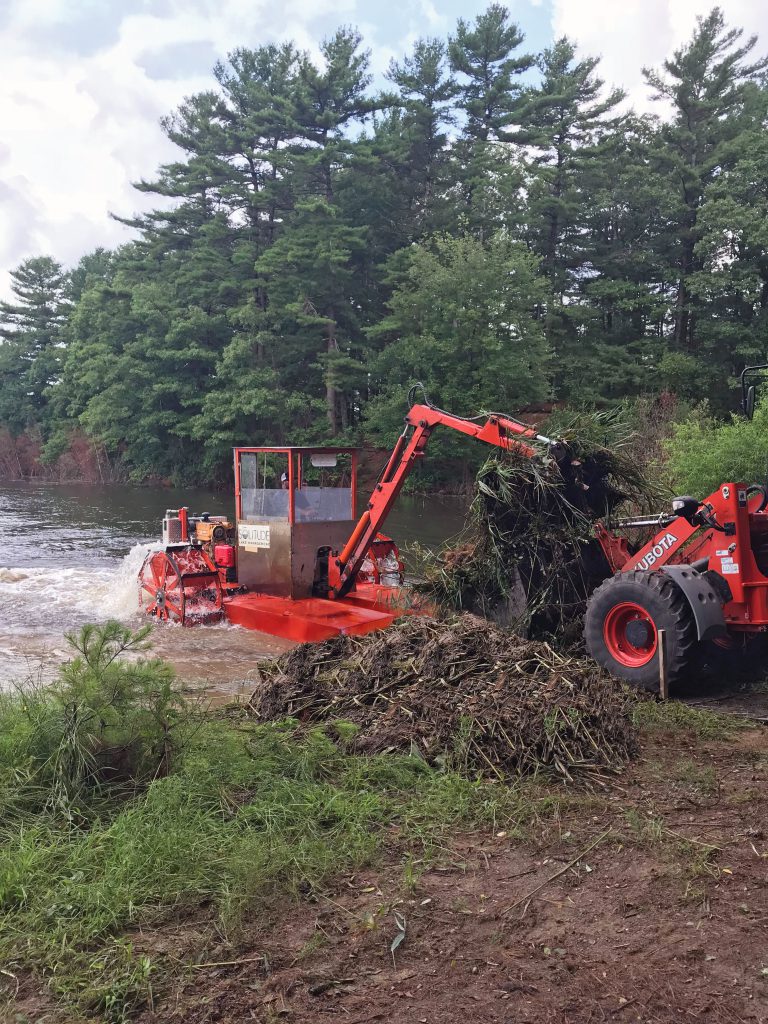
3 Tools and Technologies For Invasive Species Management
All lakes and ponds are susceptible to the growth of nuisance and invasive aquatic plants. Proactive maintenance is key to prevent the invasion of an undesirable plant, but if a species has already taken hold, property owners can successfully manage the growth with a few different mechanical solutions.
Mechanical aquatic weed removal services encompass two distinct management tools and approaches – plant harvesting and hydro-raking. While both provide ecological benefits, it is important to distinguish which option is better suited for the specific management challenges plaguing your lake or pond.
1. Mechanical Harvester
The aquatic weed harvester is a floating barge that cuts and effectively removes nuisance vegetation and algae from the surface of the waterbody. The plant material is collected and then offloaded, either into a container to be transported offsite or to a designated compost area. Mechanical lake weed removal offers an eco-friendly solution that does not create temporary water use restrictions during or after the work. The aquatic weed harvester has been proven effective on water chestnut (Trapa natans), giant salvinia (Salvinia molesta), water soldier (Stratiotes aloides), water hyacinth (Eichhornia crassipes), and a multitude of other species found throughout the country.
Mechanical Harvesting Explained
2. Hydro-rake
A hydro-rake is also a floating barge run by two hydraulic paddle wheels, but is equipped with a 12-foot hydraulic arm and specialized attachment that is used to rake the pond bottom and remove detritus, organic sediment, and aquatic vegetation that is attached by root systems. The hydro-rake, having no on-board storage, must offload the collected material directly onshore for off-site disposal, or to pair with shoreline restoration efforts using SOX Solutions. This approach has proven effective on a number of aquatic plants such as cattails (Typha sp.), purple loosestrife (Lythrum salicaria), watershield (Brasenia schreberi), Alligator weed (Alternanthera philoxeroides), and many others.
Hydro-raking can also serve as a more environmentally friendly and cost-effective alternative to dredging. If a lake or pond is periodically maintained through hydro-raking, the need to perform a large-scale dredge project may be negated, saving financial resources and prolonging the down-time and ecological disruption in the process.
Both aquatic weed harvesting and hydro-raking collect plant biomass before it decomposes and contributes to the organic muck layer, maintaining or increasing overall water depth. In addition to the plant biomass, these mechanical options remove the associated nutrients (phosphorus and nitrogen) that contribute to increased plant and algae growth and, potentially, eutrophication.
Restore Depth To Your Waterbody
3. Drone Technology
Mechanical solutions are a highly effective, natural alternative to herbicides, but sometimes it is most beneficial to pair the two approaches. This brings us to our newest “mechanical” technology – drones. Though very different from hydro-rakes and harvesters, drones are extremely beneficial for invasive species surveillance on a project site. The remote operation of a drone allows our teams to refrain from entering delicate or dangerous habitats, enhancing overall safety and project efficiency.
As needed, highly-maneuverable drones can also be equipped with EPA-registered herbicides for remote application across affected locations. Furthermore, drones can be pre-programmed with flight routes for precise application without impacting non-target areas. When completed together, herbicide applications and mechanical harvesting or hydro-raking can successfully eliminate future invasive plant growth and encourage native plants to reclaim their habitat.
These paired services are often performed as a multi-year effort, and then followed with a long-term management proactive program that may include nutrient mitigation, aeration and Oxygen Saturation Technology, shoreline restoration, buffer management, and other beneficial solutions. When your waterbody is professionally surveyed and maintained year-round, you can worry less about aesthetics and functionality, and focus more on overall enjoyment of the water with friends, family, and neighbors.
All About Advanced Drone Technology
Who We Are
At SOLitude Lake Management we’re dedicated to making water a more healthy and beautiful part of our environment and our world. In that pursuit, we offer sustainable, comprehensive lake and pond management solutions.
SOLitude Lake Management is a nationwide environmental firm committed to providing sustainable solutions that improve water quality, enhance beauty, preserve natural resources and reduce our environmental footprint. SOLitude’s team of aquatic resource management professionals specializes in the development and execution of customized lake, pond, wetland, and fisheries management programs that include water quality testing and restoration, nutrient remediation, algae, and aquatic weed control, installation and maintenance of fountains and aeration systems, bathymetry, shoreline erosion restoration, mechanical harvesting and hydro-raking, lake vegetation studies, biological assessments, habitat evaluations, and invasive species management. Services and educational resources are available to clients nationwide, including homeowners associations, multi-family and apartment communities, golf courses, commercial developments, ranches, private landowners, reservoirs, recreational and public lakes, municipalities, drinking water authorities, parks, and state and federal agencies. SOLitude Lake Management is a proud member of the Rentokil Steritech family of companies in North America.












